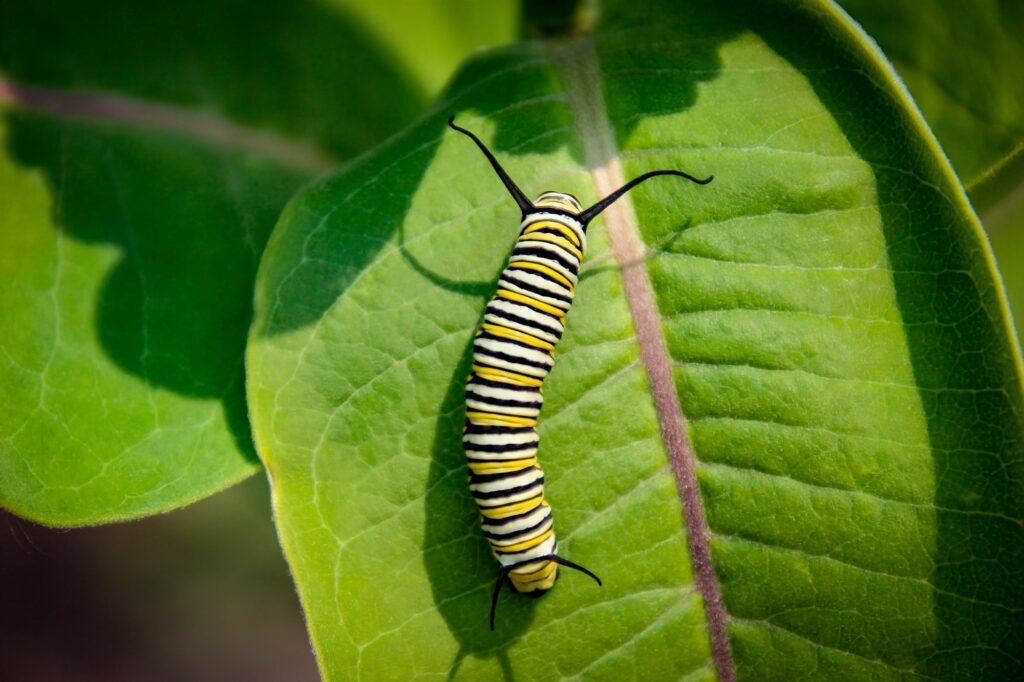Many caterpillars exhibit certain food preferences that persist when they become butterflies: for example, monarch butterflies feed exclusively on milkweed, while lime butterflies prefer linden leaves.
Researchers at the National University of Singapore (NUS) are investigating the origins of these food preferences.
Caterpillars’ scent preferences
Previous research by NUS researchers has shown that within a few days, caterpillars develop a preference for the smell of leaves they eat outside of their usual diet, and pass this preference on to their offspring.
This adaptation occurs naturally when female butterflies lay their eggs on atypical plants: the caterpillars that feed on these new plants develop a preference for the new odor and inherit it, which could lead to host switching and the formation of new species with different dietary preferences.
“Because novel food preferences develop in the larval brain, it was unclear how these preferences are passed on to offspring,” said Professor Antonia Monteiro, who led the research team.
“Offspring develop from the fusion of two cells – an egg and a sperm – produced in the parents’ gonads, far from the brain. How odour preferences are transmitted to these cells was unclear,” explained V. Gowri, a PhD student at NUS and lead author.
Scent preferences across generations
To understand this adaptive behaviour, the team conducted experiments and found that the hemolymph, the larval blood that permeates both the brain and reproductive organs, contains factors that promote the inheritance of new odour preferences.
Larval blood may transport factors from the brain to the gonads to influence the olfactory preferences of the next generation, or, if contained in sperm or eggs, may transport these factors from the food to the fetal brain.
Food preferences in larval blood
To test whether the larval blood contained such factors, the researchers fed newly hatched larvae either the novel-scented plants or a control plant, then took blood samples from mature larvae and injected them into larvae that had not eaten either plant.
The researchers found that larvae that received blood from control larvae maintained their normal diet, whereas larvae that received blood from larvae that had eaten the novel-smelling plant adapted to this change in diet. Remarkably, their offspring inherited this new preference.
“This experiment was quite surprising to us because it shows that olfactory preferences can be learned without the odor having to enter the larvae’s body through the antennae, as suggested in textbooks,” Monteiro said.
Mechanisms of odor learning and preference
The discovery suggests a possible mechanism by which larvae change their food preferences over evolutionary time, and the researchers aim to investigate this further to identify specific factors that are passed on across generations.
“These results indicate that factors in the hemolymph, and possibly the odor molecules themselves, play an important role in odor learning and the transmission of preferences across generations,” the study authors wrote.
“Furthermore, this mechanism of hemolymph-mediated inheritance of odor preferences bypasses peripheral odor sensing mechanisms performed in the antennae, mouthparts, or legs, and may mediate food plant switching and diversification in Lepidoptera, or more broadly across insects.”
Monarch Butterfly and Milkweed
Monarch butterflies and milkweed have an interesting and important relationship. Monarch butterflies are highly dependent on milkweed for their survival. Female monarch butterflies will only lay their eggs on milkweed plants because their larvae (caterpillars) feed on milkweed leaves as their only food source.
And the relationship goes beyond just being a food source: Milkweed contains toxic compounds that are ingested by the caterpillars, making them inedible to predators.
This toxicity carries over to the adult butterfly stage, protecting the butterfly throughout its life. The monarch butterfly’s bright orange and black wings are a warning sign to predators: “Stay away! It tastes awful!”
This dependence means that milkweed is essential to the survival of the monarch butterfly. Unfortunately, habitat loss and herbicide use have led to the decline of milkweed and monarch populations are declining.
Many people are now planting milkweed in their yards to help protect these amazing creatures – a simple but effective way to contribute to monarch butterfly conservation.
The research was published in the journal Biology Letters.
—–
Like this article? Subscribe to our newsletter for more fascinating articles, exclusive content and updates.
Check it out with EarthSnap, a free app brought to you by Eric Ralls and Earth.com.
—–


